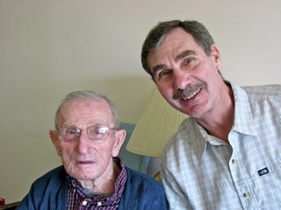
He had made it clear that he wanted to survive only if he had the resiliency to do it on his own. He had always been self-reliant; he didn’t want artificial resiliency imposed on him at the end.
My Father encountered and overcame many adversities in his life. He married just before leaving for Africa in World War II. Shortly after he arrived his wife died accidentally. He was not permitted to return home from the war for her funeral. Before the War life was difficult. He was part of a large immigrant family, 9 children in total, that struggled to make a home in the United States. He was nine years old when the Great Depression hit. He helped his family manage during this crisis until he was inducted into the Army when he was 22. He survived the War and the deaths of his parents and three brothers.
I know that he and my Mom had difficult times during their relationship, but they both worked to not have their problems become our problems. He was committed and devoted to his family. My Mom experienced a number of serious health problems. She was diagnosed with lymphoma and went through a course of chemotherapy. She later had a series of cardiovascular problems that required surgeries. Throughout all her health difficulties my Dad remained at her side and optimistic.
My Mom died eleven years ago during open-heart surgery. She was kept alive with machines for a few days hoping that her heart would recover and take over – it didn’t. Dad had to make the decision to let her pass. I know he was deeply pained, as we all were by this experience. After Mom’s death, Dad lived on his own, frequently visiting her grave to leave flowers.
He kept active playing golf, attending church and mowing the fairways at his country club. After being away for many years I had the opportunity to move back into the. We became good buddies. We bought season tickets to UCONN football and enjoyed our tailgate lunches before each game. He enjoyed visiting our home, making friends with our neighbors and taking trips over the holidays to see his granddaughters and great grandchildren.
He no longer takes in food or liquids; he does not speak – it’s only a matter of time before his body will shut down. I know there is no going back and I know that this is his choice. It’s not easy watching the ebb and flow of his breathing – there are times when his chest stops. I place my hand on his chest wanting him to breathe and at the same time to not suffer. After a short time he takes in another breath and so do I.
The nurse listens to his heart and lungs and marvels at how strong it is. He has a resilient heart. Even under these extreme conditions it keeps beating. His heart always pursued life and now it is carrying him to the precipice of death.
I realized that when resiliency flourishes in one’s life – there is no giving in or up. This man never did, why should his heart? It knew only one way; it had only one choice; it must go through a process of using up every last resilient beat.
I just knew that his chest wouldn’t rise again. After three days of knowing, I still wasn’t prepared. My hand and his chest were motionless. My heart was desperately reaching for its resiliency.
The power of resiliency is astounding and positive and yet there is a hardness to it. The process of overcoming and transforming adversity in one’s life is not easy or pleasant and sometimes can be painful. Resiliency doesn’t promise an easy road it; only promises to take you down that road as far as you want to go.
My Dad came to that point in his journey. I know it was easier for him to accept than it is for me. What I will remember most is the twinkle in his blue eyes, his loyalty and his resilient heart.


 RSS Feed
RSS Feed
